I disagree.
To me, intelligent design is just creationism in a pseudoscientific package. Once you start trying to define the "intelligence" behind intelligent design, it starts sounding an awful lot like God, and God and science don't exactly go hand in hand. My friend disagrees, and then went on to say that, "Evolution is just a theory, anyway. Why not teach more than one theory?"
Rather than argue that my friend validates the theory of evolution every year by insisting on a new flu shot, I've decided instead that they're right: why not teach more than one theory? My friend Justin, who is pretty smart (I used to be smart, but I spent my twenties drowning my intellect in fried cheese and fruity drinks in gigantic glasses; now I'm sometimes confused by mirrors and often think that prime numbers have something to do with cuts of beef), explained this once by pointing out that in the same way that you should not bake muffins in gym class you should not discuss religion in science class because they have nothing to do with each other. I tend to agree, but where's the fun in that?
Instead, I want Tennessee to fully embrace this law by teaching multiple theories of evolution and the origin of life. I want the Darwinian model, of course, but would also like for them to cover intelligent design, spontaneous generation, Prometheus fashioning men from clay, twin brother hero-gods crafting the first men from maize and chili peppers, the Flying Spaghetti Monster touching Earth with his Noodly Appendage, the Great Egg splitting open and spilling forth All That Is Known, Earth-Woman falling from the sky to land on the back of a giant turtle, and Adventure Comics #333:

Our story opens with Superboy visiting his friends, the Legion of Superheroes, in their native time period of 30th Century Earth. There aren't any Sun Eaters or sentient buildings that need attention, so the Legion is working on an archeology project when they make a shocking discovery:
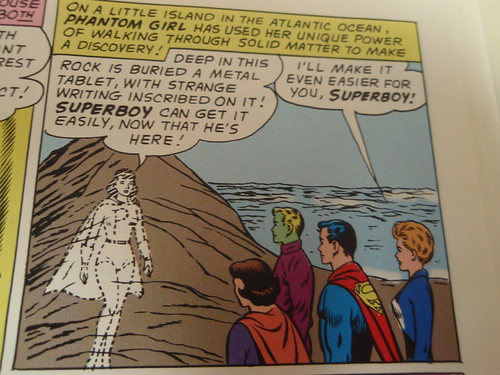
A strange metal tablet, you say? Let's check it out, with some science!
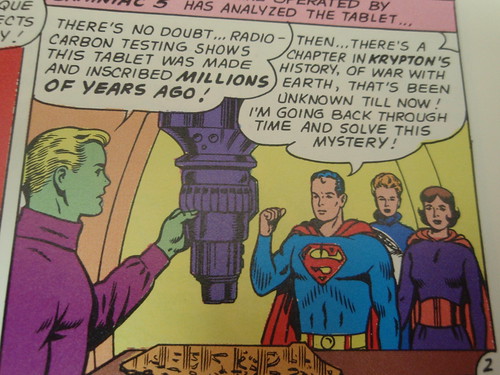
Radio carbon dating is real, adding further validity to this story. Anyway, the team decides to use their time bubbles to investigate this mysterious war between Krypton and Earth, so half of them go to ancient Krypton while the other half goes to ancient Earth.
Team Krypton runs into a little trouble, in that Krypton is a primitive planet with no scientists around, which makes it a little difficult to commit interstellar war. Saturn Girl may have a solution, though:
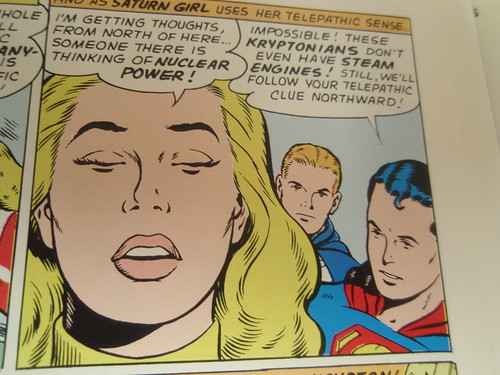
Superboy, by the way, is a total dick here.
"That's impossible, but even though you're probably wrong we'll go ahead and check out your lead, anyway."
At least he doesn't add that they're just humoring her because she's a girl. It wouldn't be at all surprising, given how rough women had it in Silver Age comics, but instead Superboy's reasons for being a dick in this particular case go unspoken. So does his apology for doubting her when they actually do run into a scientist:

It turns out that Krypton hates scientists because they accidentally obliterated a city through a nuclear accident, so the government banned all science in response, adhering to their campaign slogan of "Babies Shouldn't Be In Bathwater, Anyway!" The scientists are slowly constructing a space ark, so that they can go colonize prehistoric Earth, so the Legion decides to help:

Wait, did he just say they were bringing giant lizards?
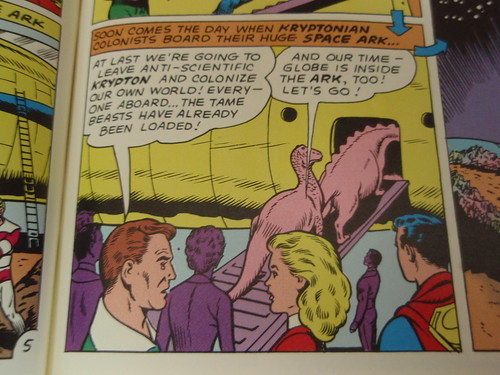
Yeah, he did.
Meanwhile, back on prehistoric Earth, Brainiac 5's team makes a shocking discovery:
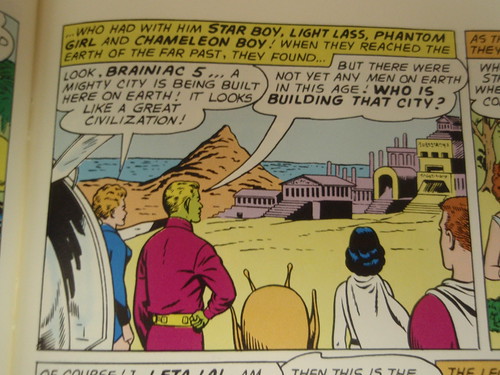
They found Atlantis:
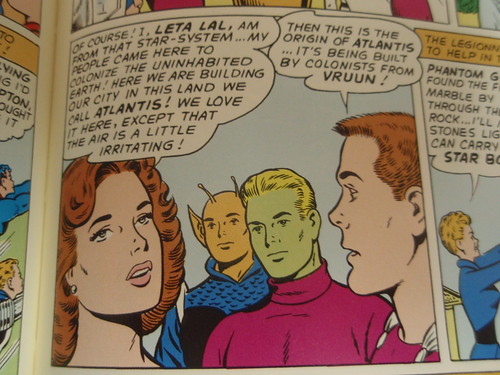
They also found Leta Lal, complaining about the air quality.
Now, for those who don't know Silver Age comics, this girl might as well have a sign over her head that says "love interest", because you just know Superboy is going to fall for her. Superboy, and later Superman, continuously and consistently falls for the LL combo: Lana Lang, Lois Lane, Lori Lemaris, Luma Lynai, Lyla Lerrol, Lola-La, Lex Luthor... wait, that last one only happened in my imagination while I was watching "Smallville". Anyway, sure enough, the minute they set eyes on each other, sparks fly:
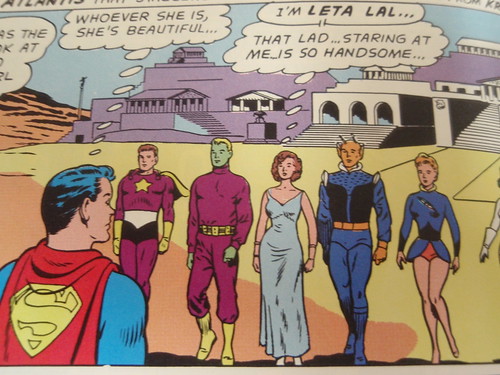
Unfortunately, Saturn Girl and Brainiac 5 immediately start bickering:
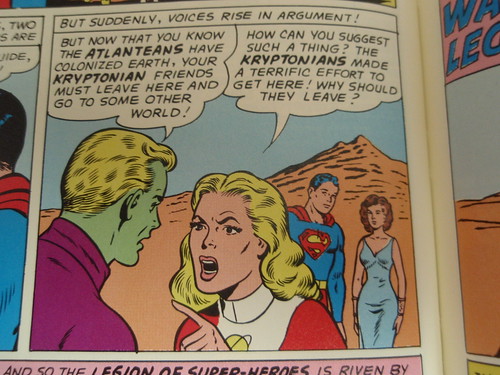
Two important things about that panel:
1) Superboy looks so irritated. "Guys, I'm trying to, you know, hit on this prehistoric alien chick over here. Could you keep it down?" Given that this is a Silver Age comic, they're lucky he didn't turn them into hags or force them both to marry Jimmy Olson just to teach them a lesson.
2) The Legion just started the war that they came back in time to investigate. By the end of the story, one of them will probably end up being their own grandfather.
There are several pages of fighting as the Kryptonian scientists battle the Vruunian colonists, aided by the Legionnaire instigators who, instead of being heroic, instead allow the hostilities to escalate to the point that the Kryptonians, who have been shunned on their own world for unleashing nuclear armageddon, decide that the best course of action is to unleash nuclear armageddon:

Saturn Girl, recognizing that the Kryptonian missle launch behind her is more important than the Kryptonian missle that Superboy's trying to launch over in Atlantis with Leta Lal, heads off disaster, and then Brainiac 5 makes a shocking discovery:
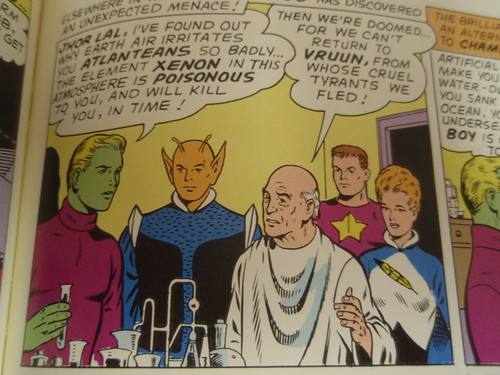
and suggests an even more shocking solution:
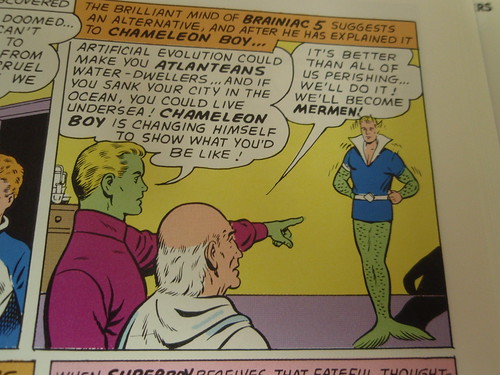
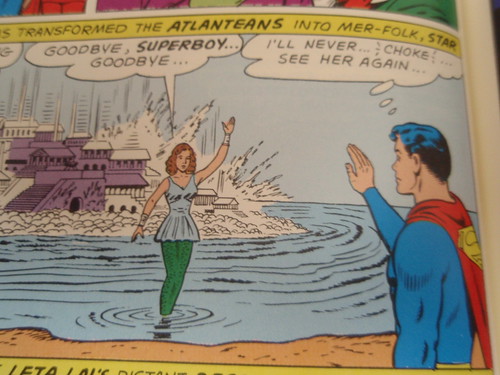
So, to sum things up, the Legion brings dinosaurs to Earth, starts a war, helps a bunch of people kill each other, stops the war that wouldn't have happened in the first place, and then invents Atlantis. As for those Kryptonian scientists, well:

It turns out that they got Jurassic Park-ed by their allegedly tame helper lizards.
So, what's the moral of the story?
Who cares? Morality has no place in high school Biology, where I'm going to lobby my local school board to be sure that "Adventure Comics" #333 is taught.
7 comments:
Mormons are from Krypton? Who knew?
Of course we are! That's why we know how magnets work. Also why we won't tell anyone else. See: superdickery
Also, my word verification was "ramosess"...as in Ra-Moses, aka Ramses II, aka Ramses The Great, aka Pharoh from the Old Testament. Sweeeeeeeet....
I love this. I agree that if intelligent design is included in the science classroom we might as well just start making up theories. If you want religion taught, send your kids to private school or teach it to them yourself.
Even with its "creationism undercover" origins (and, I would argue, current thrust), I'd still welcome ID if it was a scientific theory. It is not. A scientific "theory" is a well established, highly tested hypothesis that is as close to indisputable fact. It's not like the vernacular use of theory as an educated guess/shot in the dark. ID doesn't offer a scientific explanation. It critiques a scientific theory using less than scientific tests, and then leaves one to deduce that a force beyond science is responsible. That step (along with the pseudoscience that precedes it)disqualifies it as a scientific theory. It is a theory in the vernacular, non-scientific sense. Even as a scientific critique it fails, and on two grounds. First, the "science" it bases itself on is not science. It's misinterpretation, semantics,and fallacy after fallacy. Secondnly, and most importantly, even if one assumed that its arguments were valid, they fail to "disprove" or poke holes in evolutionary theory. Irreducible complexity is the prime example...as a family member pointed out to me, it's fantastic as a test of evolutionary theory. The only problem being is that evolution passes the test. There is no such thing as irreducible complexity. I don't say any of this to cast aspersions on ID in general, just on the mindset that it's somehow science, or belongs in a science classroom. It isn't, and doesn't. In terms of science, regardless of the general public, it is a fringe theory, and there is not appreciable controversy. Personally, I like that ID makes a step toward reconciling Young Earth creationism with modern science. It just tries to artificially stop that process mid-step, and fails in doing so. God is not ruled out of evolution in any way. Evolution explains the how, not the why.
Intelligent Design is just as scientific as "I don't know how it works, therefore ALIENS!"
I've already made a serious post, so I will just say ...want this: http://controversy.wearscience.com/
It is completely wrong to assume that the idea that there are multiple theories of evolution must be creationist/intelligent design. It is a fact that there are several different theories of evolution. No, "microevolution" and "macroevolution" cannot be universally accepted as distinct theories. There are evolution theories that considers them to be scales of the same thing, although other theories of evolution (such as Ian Tattersall's inbreeding punctuated equilibrium) actually distinguishes between microevolution and macroevolution WITHOUT endorsing creation or intelligent design. Classical complexity-constructive neo-Darwinism is actually not the same theory as the limiting factor neo-neo-Darwinism that contains admixture of neutralism. The latter, which appears to be the mainstream opinion, has clearly given up trying to explain the information content of organisms by referring to limits to how many mutations per generation that can be purged by natural selection. The mainstream version runs into serious trouble considering that only one hereditary disease out of 20 can be explained by officially acknowledged functional DNA, meaning that evolution must work on a scale massively greater than thought possible to be viable. As shown on Pure science Wiki (the pages "Self-organization" and "Inheritance of acquired characteristics") a modernized version of Lamarckism (quite distinct from the classical version) based on working biological contexts sending complaints about proteins that do not do their job properly to the responsible genes can solve the paradox.
Martin J Sallberg
Post a Comment